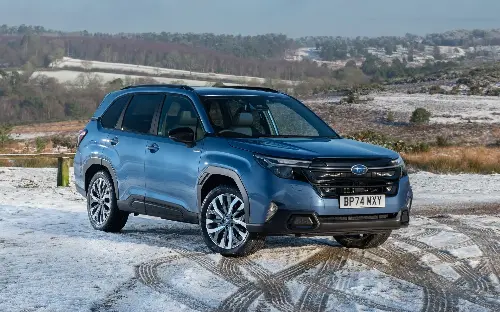
The latest Subaru Forester is that rarest of things: a new car that has less power than the one it replaces.
Where the old Forester could boast 148bhp, the new one has 134bhp. And while power isn’t everything, you could be forgiven for wondering whether that’s sufficient to power a chunky mid-sized SUV.
Forester is one of Subaru’s best known nameplates – second only to the Impreza in Europe, in fact – and has been around for almost 30 years and five generations. Yet this mid-size hybrid SUV has barely made a mark in the UK – in spite of the fact that such things seem to be all the rage these days.
Subaru will be hoping this latest version arrests that trend. But for that to be the case, buyers will have to agree that less is, in fact, more.
Pros
- Comfortable ride
- Lots of room in the back
- Competitive price vs 4wd rivals
Cons
- Thirsty, anaemic powerplant
- So-so boot space
- Dated touchscreen
Under the skin
I’ve sampled this car before, briefly, on an off-roads course and a test track in Germany. Now I have a UK-spec car on the roads of rural Warwickshire – prime Forester country, in other words, where the Cotswolds bleed into the West Midlands.
The new 134bhp powertrain is the only one offered; it sits somewhere between mild and full hybrids, operating the same way as the latter but with such a small battery and motor that it’s only really as effective as the former.
It’s based around Subaru’s horizontally-opposed 2.0-litre petrol engine, driving all four wheels permanently and symmetrically through a continuously variable transmission (CVT).
It’s not fast – 0-62mph comes up in a laboured 12.2 seconds – and neither is it particularly economical, with an official fuel consumption figure of only 34.9mpg. The inescapable impression is that a diesel engine, or perhaps a full hybrid, might have felt far more at home.
What’s more, with even the base model starting at a fiver shy of £40,000, it appears to be rather pricey. By comparison, an entry-level Volkswagen Tiguan or Skoda Kodiaq cost just over £37,000; a Kia Sportage, meanwhile, starts at £30,000-odd.
However, none of these has four-wheel drive as standard. Indeed, four-wheel drive in an SUV is becoming an increasingly difficult to come by – fine if your SUV is going to spend its time in suburbia, ferrying kids from school to swimming pool to soft play to skating rink and so on.
All-wheel drive
But if you live in the sticks and regularly need to contend with slippery surfaces, or tow, four-wheel drive is essential. You’ll have to spend more than £40,000 to get a version of these rivals that’s so equipped, making a base-model Forester look decent value. If four-wheel drive isn’t necessary, it will cost you more than you really need to spend.
So despite less power, what do you get that makes the new Forester worthwhile?
Subaru is keen to highlight just how deep and meaningful its upgrades have been. Its engineers have used 19 metres more structural adhesive in the new car than the old, increasing rigidity by 10 per cent. There’s high-absorption mastic in the roof, with the aim of improving sound deadening, too.
Inside, views outward have been improved by lowering the waistline, while medical specialists were brought in to improve the seats’s support and reduce head movement. Even the area of the seats that are heated has been increased.
And if you’re looking for the most on-brand, Subaru-est thing about the Forester, it’s this: the sat-nav system will now accept What Three Words destinations, allowing you to pinpoint specific destinations to within three metres. “If, for example, you’re a vet,” Subaru’s UK MD Lorraine Bishton tells us, “you can tell the car exactly which gate in which field you need to go to.”
Touch sensitive
You might therefore be expecting a fairly utilitarian level of finish inside, but the Forester actually feels pretty plush, especially compared with the dated feel of the previous version.
The dashboard is attractive to look at, there’s a nice amount of soft-touch plastic and while the overall effect doesn’t give you quite as much of a feel-good factor as, say, a Mazda CX-5, neither does it feel like a poor relation.
There are big, thunky indicator stalks and large, thumb-sized buttons on the steering wheel, all of which make the Forester feel chunky and easy to use. It’s a bit of a shame this doesn’t extend to a proper climate control panel, but at least there are buttons to adjust the temperature, as well as an always-on section of the touchscreen display for the rest of the settings.
It’s a bit of a shame that the rest of the touchscreen feels slightly archaic to use. It’s slow to respond to your touch, while the graphics look like something you’d have found on a gaming console settings menu, circa 2005.
Its saving grace is that it’s massive, with quite a low resolution, with the result that all the icons are huge and therefore very easy to select with bouncing, joggling fingertips.
Riding high
But the Forester rides well enough that they won’t be bouncing or joggling all that much. Granted, it can’t quite mask all of the potholes and bumps, and sudden ones elicit an uncouth thump from the wheels, but the suspension set-up is very much toward the softer end of the spectrum.
As a result, it doesn’t go around corners brilliantly – there’s a lot of body lean, while the steering feels remote and over-assisted. Not that you really buy one to sling around; even so, most of its rivals feel more planted.
What does matter with a car like this is the amount of space. Here the Forester does well – mostly. It’s at its most impressive in the back seats, with a vast amount of leg room; those in the front won’t feel short changed, although the width of the centre console means its plastic surround can get in the way of your left knee occasionally.
The boot will take 508 litres, which is… OK. But most of the Forester’s rivals offer at least a little more – a Tiguan has 145 litres more.
Power play
What about the engine? It would be lovely to say you don’t notice its lack of power on the road – but that would be a lie. This is a lot of car for the relatively anaemic powerplant to haul and it tells you about it vocally and often. The continuously variable gearbox causes it to raise its voice every time you tread on the accelerator pedal.
For all that noise, you don’t get much in the way of forward motion. Indeed, on a motorway you dread being caught behind a slow-moving HGV, lest you have to mash the accelerator to the floor simply to get back to cruising speed. And this is with only one person on board; fully laden, or hauling a caravan, it would feel even more of a struggle.
The Telegraph verdict
If you need the Forester’s talents off the road, you might have been hoping that the refinements would move it closer to its less utilitarian rivals on Tarmac.
They have – up to a point. The Forester is now more comfortable than ever and feels much closer to its rivals in terms of its interior finish – even if it hasn’t surpassed them.
But what this car really needed to finish it off was a convincing powerplant. Because it lacks one, the Forester always feels strained – especially when it’s lugging heavy loads. And it’s hideously thirsty to boot.
If you really need a four-wheel-drive SUV that spends more time off the road than on it, maybe you can see past these flaws in favour of the Forester’s genuine go-anywhere ability, as well as its competitive price. Otherwise, there are better options.
The facts
On test: Subaru Forester 2.0i Touring
Body style: five-door SUV
On sale: now
How much? £44,100 on the road (range from £39,995)
How fast? 116mph, 0-62mph in 12.2sec
How economical? 34.9mpg (WLTP Combined)
Engine & gearbox: 1,995cc four-cylinder petrol engine, continuously variable gearbox, four-wheel drive
Electric powertrain: AC permanent magnet synchronous motor with 0.57kWh battery, no external charging facility
Electric-only range: 0 miles
Maximum power/torque: 134bhp/134lb ft
CO2 emissions: 183g/km (WLTP Combined)
VED: £2,190 first year, £620 next five years, then £195
Warranty: 3 years / 100,000 miles
Spare wheel as standard: no (not available)
The rivals
Volkswagen Tiguan 2.0 TSI 204 4Motion R-Line DSG
201bhp, 36.5mpg, £46,700 on the road
Choosing a Tiguan with four-wheel-drive means you have to go for the R-Line, which results in a firm ride due to the large diameter wheels. It’s also quite a bit pricier than the Subaru. But the interior is more up-to-date, the boot is much larger and there’s considerably more power; yet it’s also slightly more economical, which really makes you wonder what the Subaru’s hybrid powertrain is there for.
Mazda CX-5 2.2 Skyactiv-D Homura AWD Automatic
181bhp, 44.8mpg, £41,450 on the road
It’s hard to see why you’d prefer the Subaru when this top-of-the-range version of the CX-5 is a lot cheaper. It’s more powerful, more usable, higher quality, just as roomy, better to drive and better equipped than the top-of-the-range Forester – and, thanks to its diesel engine, it’s considerably more economical, too. Unless you really need the Subaru’s off-road ability, it’s a no-brainer.
Honda CR-V Advance AWD
181bhp, 42.8mpg, £49,030 on the road
Probably a far better way to sample a hybrid SUV, now that the Toyota RAV4 is a plug-in hybrid only. The CR-V is smooth, classy, comfortable and huge inside – but it’s also expensive. Yet if you do enough miles you will make your money back in fuel savings compared with the Forester.
